7 Most Beautiful Greek Islands for Vacation
With thousands of islands to choose from, there is no doubt that Greece is one of the best places to do nothing while enjoying idyllic landscapes full of history. These days when spring is showing its face, take off your slippers that have dust in the corner of your wardrobe and start planning your perfect Greek islands vacation getaway early. Each Greek island has its own secret. So whether you’re after breathtaking views, sea adventures or a trip back in time, our list of some of our favorite islands will help you find that perfect place to satisfy your inner Greek god or goddess.
1. Paros and Antiparos, Cyclades Islands

Taking an adrenaline-filled scooter ride on the winding roads of the capital Parikia, feeling the wind in your hair, is definitely the best way to see Paros. While walking around the city, the characteristic glossy and translucent marble of this place, which is also used in the Venus de Milo sculpture exhibited in the Louvre museum in Paris, will definitely catch your eye. If you want to continue seeing the marble statues, you can visit the 4th century Panagia Ekatontapiliani, the Church with 100 Doors. On the beaches in the southern part of the island, kitesurfers defy the famous Cycladic winds. The small and secluded Island of Antiparos, reached by a sea voyage of less than 2 kilometers; It is the perfect island to explore the clear blue creeks, hunt sea urchins and take a walk among the cedar trees. For those who know no limits in sunbathing, there are various beaches around the island where clothing is optional and special for naturists. Soros beach and the coves in Agios Georgios are the best options for a quiet swim in the deep blue waters. If you wish, you can get closer to nature by pitching a tent in one of the island’s numerous organized camping areas. The shade of the trees, the gentle breeze and the scent of wild plants will be the only lullaby you will need to fall into a deep and peaceful sleep.
Getting there: You can take the ferries from Piraeus, Rafina and Lavrio – the journey takes 3-5 hours depending on the type of ferry you choose.
2. Island of Crete
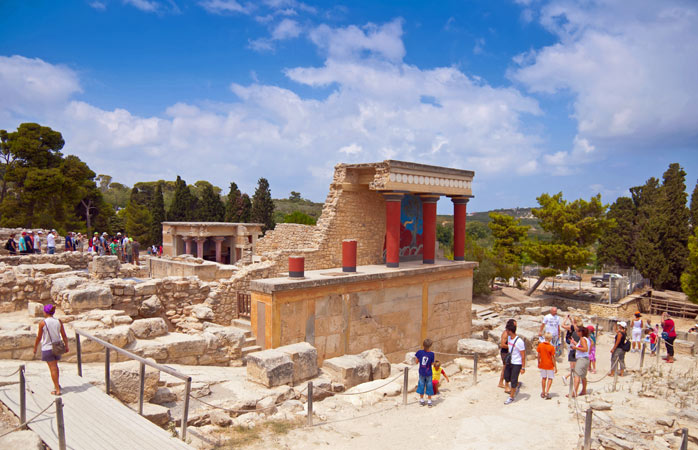
Crete is the largest of Greece’s sister islands, with over 1000 kilometers of coastline. While you are driving from coast to coast, you will have the opportunity to enjoy the natural beauties of the island such as mountain and sea views. While touring the island, don’t forget to keep your eyes peeled for the brown road signs that show the historical monasteries and ruins that are worth the length of your way. The Archaeological Museum of Heraklion houses a collection of Minoan artifacts, including frescoes from 1800 BC, including the famous attacking bull fresco in the Palace of Knossos. You can’t go to Crete and enjoy the Cretan food style, which is famous for being healthy and balanced. Seasonal produce, fresh fish, olives, homemade breads and local cheeses feature in most dishes. In Crete, dinner is eaten as late as 10 o’clock; so you can pour yourself a glass of ice-cold raki and watch the outdoor tables fill up in the evening. Those with a more discerning palate may prefer Cretan snails dipped in olive oil, lemon juice and wild thyme, one of the best examples of the island’s slow food culture. You can end your day by lounging by the pool at the 5-star hotels in Elounda and feeling like the king of the Mediterranean, or you can dominate the night by attending parties in Malia, the center of nightlife.
Getting there: The easiest way to get there is by plane to Haniá, Iráklio (Heraklion) and Sitía airports on the island.
3. Lefkada, Ionian Islands
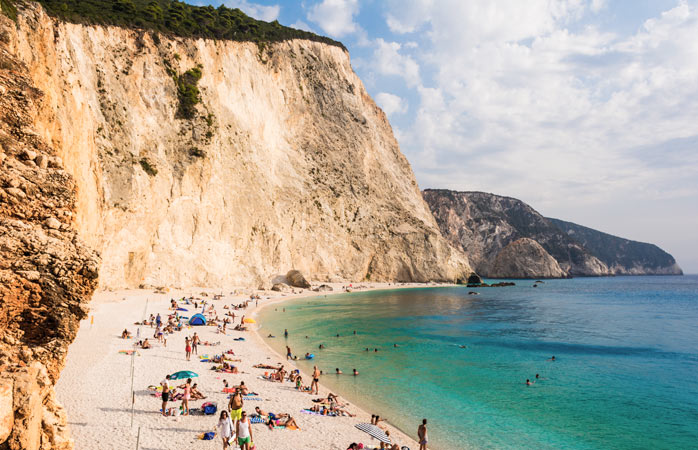
Would you believe it if you heard that you can reach this island paradise by road? A small bridge connects mainland Greece to Lefkada, where you will find the turquoise coves of the Ionian Sea. The white cliffs, the most beautiful view of the island, await you at Egremni beach. If you want to take a trip in time accompanied by the magic of the olive groves and the locals sweeping their gardens, you should head towards the interior of the island and stop by the ancient Sfakiotes resort, which consists of various historical settlements. People start their days of laziness here with cold coffee to stay cool under the hot sun and end with an ice-cold ouzo. The liveliest place to spend the evening is the square across from St. Spiridon Church in Lefkada district. Here you can encounter everything from religious ceremonies to outdoor performances. The church sits in the middle of the open-air tables of busy restaurants, so feel free to join the conversation over traditional Greek food.
Getting there: There is no need for a sea voyage as the island is connected to the mainland by a bridge. For those with time, a 5-hour bus ride from Athens is a great option.
4. Samos, North Aegean Islands
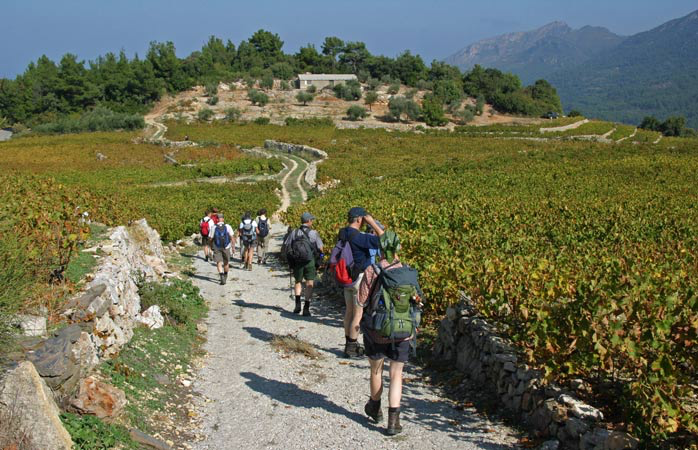
According to Greek mythology, you can find Samos, the birthplace of Zeus’ wife Hera, in the Eastern Aegean Sea. Of the three temples built in her name in the 6th century at the World Heritage Site Heraion to honor the goddess, only one column has survived. If you want to explore the virgin vegetation that covers the island, you can’t find a better place than the peaks of the Kerkis and Ambelos Mountains. Patient birdwatchers can also explore the open areas to spot native raptors, herons, pelicans and even pink flamingos. Samos is a place steeped in history. Here, especially during the wine festival in the capital Vathy in early August, the number one choice of people to quench their thirst is the sweet limes of Samos. Muscat is said to be a type of historical grape used by the Ancient Greeks, and later reached France thanks to trade. While other vineyards of Europe were destroyed in the 19th century by the phylloxera plague (the vine lice prevent their development by laying eggs on the vineyards), you will find a wide variety of historical ties on the island, thanks to the fact that these here continue to thrive due to their isolated status.
Getting there: For air transportation, you can choose a 45-minute flight from Athens or take a 3-4 hour ferry ride from Chios.
5. Chios, North Aegean Islands
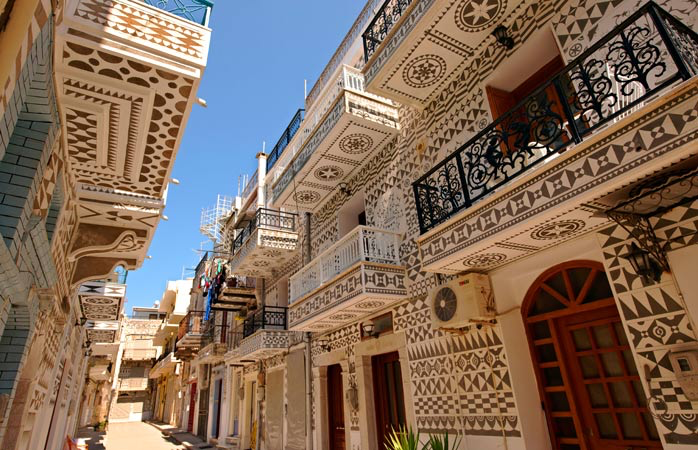
Gum is almost a magical secret, and the Greeks seem intent on keeping it that way. You better prepare to get lost in the tunnels that lead to the rooftops and private gardens as you explore Mesta, a medieval town and a defensive labyrinth. Perched on a high hill overlooking the island, the ghost town of Anatavos has a tragic story. Abandoned after the Chios massacre of 1822, the city is a national monument run by a few locals selling local produce and appetizers. Chios is also home to a unique crop called mastica or mastic tree, the only tree that produces an aromatic mastic sap. The southern district, Mastichochoria (mastika towns), is a labyrinth of seven towns with narrow streets and elaborately decorated building facades. Black and white decorative elements wrap every inch of the city from street level to the lower and upper sections of each balcony. Even Mavra Volia beach seems to mimic this color scheme, with its black volcanic pebbles contrasting with the azure sea and bright yellow stones.
Getting there: You can get to Chios by plane from Athens (45 minutes) or Crete (just over an hour). You can also find regular cruises that take several hours from Samos or up to 5 hours depending on the ferry you choose from Piraeus and Kavala on the mainland.
6. Kilimli, Dodecanese

When lying on the beach is not enough anymore, Kilimli offers countless activities to the island travelers who are interested in sports. During Easter and the following week, the celebrations held across the island showcase diving techniques and sing folk songs about this spongy animal that made the island famous. If it’s very high above the water, the rocky terrain turns it into an endless climbing paradise thanks to thousands of safe climbing routes. If you’re skilled enough to hang on a 50-foot limestone wall covered with stalactites, the Grande Grotta, a vast cave overlooking the sea, offers an impressive sunset view.
7. Corfu, Ionian Islands
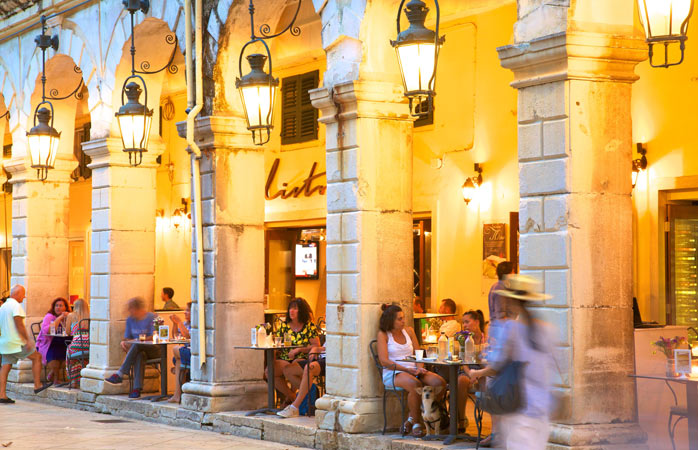
Corfu’s historic district is nothing like the blue domes and chalk-white classical Greek architecture, but rather reflects the architecture of the French, Venetian and British forces that once ruled here. Renaissance and Baroque-style buildings make up the UNESCO World Heritage Site, and it is especially dazzling with Spianada Square, where you can stroll under the shadow of archways and rotundas. While enjoying a few beaches covered with hotels that you cannot resist, you should not forget to spare time for the mountains covered with dense cypress trees. Perched high in the hills, the towns hide countless historical memories, one of which is the ancient town of Ano Korakiana, with some twenty churches scattered around it. The 220-kilometer-long Corfu Trail connects pristine nature and ruined towns with scenic trails and paved roads, protecting these towns from abandonment.





